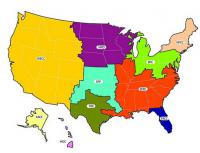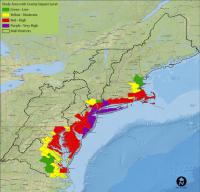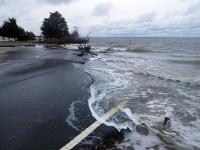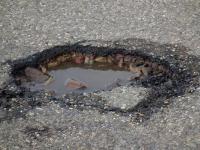-
FBI, DHS warn grid operators about cyber threats to power grid

The FBI and DHS are warning infrastructure operators about the potential cyberattacks on the U.S. power grid. The FBI and DHS have launched a nationwide campaign to alert power companies and security firms, a campaign which includes briefings and online Webinars.
-
-
Microgrids to enhance diversity, reliability, resilience
For more than 100 years, the United States electrical grid operated on a one-way delivery model: power generation, transmission, and distribution in response to user demand. Electricity came from big coal-fired plants and hydroelectric dams, later supplemented by nuclear and natural gas plants, and went out to the world as a mix of baseload and peaking power. With more renewable energy integration, smaller-scale and more widely distributed energy resources, and a demand for increased reliability and resilience, the grid of the future is shaping up to be a two-way power flow, with demand adapting more and more to available supply.
-
-
Global warming of 2.5°C degrees would put at risk trillions of dollars of world’s financial assets
An average of $2.5 trillion, or 1.8 percent, of the world’s financial assets would be at risk from the impacts of climate change if global mean surface temperature rises by 2.5°C (4.5°F) above its pre-industrial level by 2100, according to a new study. that the authors found, however, that uncertainties in estimating the “climate Value at Risk” mean that there is a 1 percent chance that warming of 2.5°C could threaten $24 trillion, or 16.9 percent, of global financial assets in 2100.
-
-
Analyzing the effects of rising sea levels in Norfolk, Va.
In Norfolk, Virginia, an East Coast city which is home to the world’s largest naval station and important seaports, catastrophic flooding could damage more than homes and roads. A new study from Sandia National Laboratories assesses how much the city, its region, and the nation would suffer in damages to national assets and lost economic activity if it does nothing to address rising sea levels. The analysis method is available to cities that want to become more resilient.
-
-
Rapid Antarctica ice melt: Sea-level rise nearly double over earlier estimates
A new study suggests that the most recent estimates by the Intergovernmental Panel on Climate Change for future sea-level rise over the next 100 years could be too low by almost a factor of two. The researchers incorporated into their models mechanisms that were previously known but never incorporated in a model like this before, and added them to their ice-sheet model, so they could consider the effects of surface melt water on the break-up of Antarctica’s ice shelves and the collapse of vertical ice cliffs.
-
-
Laser cloaking device to help us hide Earth from aliens
Several prominent scientists, including Stephen Hawking, have cautioned against humanity broadcasting our presence to intelligent life on other planets. Two astronomers suggest humanity could use lasers to conceal the Earth from searches by advanced extraterrestrial civilizations.
-
-
Fracking-related quakes make central U.S. as vulnerable as California to tremor damage

For the first time, new USGS maps identify potential ground-shaking hazards from both human-induced and natural earthquakes. The new report shows that approximately seven million people live and work in areas of the central and eastern United States (CEUS) with potential for damaging shaking from induced seismicity. Within a few portions of the CEUS, the chance of damage from all types of earthquakes is similar to that of natural earthquakes in high-hazard areas of California.
-
-
Clearer view of risky leaks from gas mains in Boston
Natural gas is considered a relatively clean fossil fuel, but a substantial amount of the gas is lost in production and distribution. In addition to the safety risks, methane (the main component of natural gas) is a major contributor to atmospheric warming. Precise measurements of leaks from natural gas pipelines across metropolitan Boston have demonstrated that almost a sixth of the leaks qualified as potentially explosive, and that a handful of leaks emitted half of the total gas lost.
-
-
Sniffing out a dangerous vapor for detecting fuel leaks, fuel-based explosives
Alkane fuel is a key ingredient in combustible material such as gasoline, airplane fuel, oil — even a homemade bomb. Yet it is difficult to detect and there are no portable scanners available that can sniff out the odorless and colorless vapor. Engineers have developed a new type of fiber material for a handheld scanner that can detect small traces of alkane fuel vapor, a valuable advancement that could be an early-warning signal for leaks in an oil pipeline, an airliner, or for locating a terrorist’s explosive.
-
-
Up to 70 percent of Northeast U.S. coast likely to adapt to rising seas

Much of the coast from Maine to Virginia is more likely to change than to simply drown in response to rising seas during the next seventy years or so, according to a new study led by the U.S. Geological Survey. The study is based on a new computer model that captures the potential of the Northeast coast to change, driven by geological and biological forces, in ways that will reshape coastal landscapes.
-
-
Helping policymakers plan for sea level rise

A new study could help protect more than thirteen million American homes that will be threatened by rising sea levels by the end of the century. It is the first major study to assess the risk from rising seas using year 2100 population forecasts for all 319 coastal counties in the continental U.S. Previous impact assessments use current population figures to assess long-term effects of coastal flooding. The data can help policymakers develop practical adaptation strategies for protecting land threatened by frequent and repeated inundation.
-
-
Microwave repairs might annihilate zombie potholes once and for all

Some potholes are like zombies – they never die. Or at least that’s the perception of much of the driving public, especially as we enter peak pothole season: late winter and early spring. Recurring “zombie” potholes are too often a reflection of the type of method that’s used to patch or “fix” them – many of which are short-lived and only marginally effective. Researchers around the world are working to develop better and longer lasting repair alternatives. Microwave technology is not yet a routine method of repair, and it’s best-suited for potholes in asphalt rather than concrete. But this approach merits further consideration. After all, given our nation’s aging network of roads, zombie potholes will continue to flourish. Microwave repair could be an effective method for keeping them at bay.
-
-
U.S. files case against Iranian government hackers behind attack on N.Y. dam

In 2013 hackers infiltrated the operations center for the Bowman Avenue Dam, a small dam on Blind Brook in Rye Brook, New York. DHS, in a classified report, later identified the attackers r identified the attackers as the same Iranian group responsible for attacks on PNC Financial Services Group, SunTrust, and Capital One Financial. Now the Department of Justice is set to file an indictment against the Iranian hackers behind the intrusion.
-
-
Sea level rise threatens more people than earlier estimated
It is estimated that 1.9 billion inhabitants, or 28 percent of the world’s total population, live closer than 100 km from the coast in areas less than 100 meters above the present sea level. By 2050 the number of people in that zone is predicted to increase to 2.4 billion. These people are the most vulnerable to the rise of the sea level as well as to the increased number of floods and intensified storms.
-
-
Are America's cities prepared for extreme weather events?
Infrastructure is, by design, largely unnoticed until it breaks and service fails. It is the water supply, the gas lines, bridges and dams, phone lines and cell towers, roads and culverts, train lines and railways, and the electric grid; all of the complex systems that keep our society and economy running. Engineers typically design systems to withstand reasonable worst-case conditions based on historical records; for example, an engineer builds a bridge strong enough to withstand floods based on historical rainfall and flooding. But what happens when the worst case is no longer bad enough?
-
- All
- Regional
- Water
- Biometrics
- Borders/Immig
- Business
- Cybersecurity
- Detection
- Disasters
- Government
- Infrastructure
- International
- Public health
- Public Safety
- Communication interoperabillity
- Emergency services
- Emergency medical services
- Fire
- First response
- IEDs
- Law Enforcement
- Law Enforcement Technology
- Military technology
- Nonlethal weapons
- Nuclear weapons
- Personal protection equipment
- Police
- Notification /alert systems
- Situational awareness
- Weapons systems
- Sci-Tech
- Sector Reports
- Surveillance
- Transportation
Advertising & Marketing: advertise@newswirepubs.com
Editorial: editor@newswirepubs.com
General: info@newswirepubs.com
2010-2011 © News Wire Publications, LLC News Wire Publications, LLC
220 Old Country Road | Suite 200 | Mineola | New York | 11501
Permissions and Policies
Editorial: editor@newswirepubs.com
General: info@newswirepubs.com
2010-2011 © News Wire Publications, LLC News Wire Publications, LLC
220 Old Country Road | Suite 200 | Mineola | New York | 11501
Permissions and Policies
